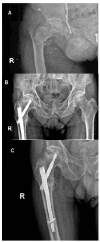Avascular Necrosis of Femoral Head-Overview and Current State of the Art
- PMID: 35742595
- PMCID: PMC9223442
- DOI: 10.3390/ijerph19127348
Avascular Necrosis of Femoral Head-Overview and Current State of the Art
Abstract
Avascular necrosis (AVN) of the femoral head is caused by disruption of the blood supply to the proximal femur. The alterations in the blood supply may occur following a traumatic event or result from a non-traumatic cause. Femoral neck fracture and hip dislocation and associated surgical procedures, corticosteroid therapy, and alcohol abuse frequently lead to AVN development. Type of fracture (displaced or undisplaced) and time between injury and surgery are the most critical factors in assessing the risk of developing AVN. Diagnosis of AVN can be established based on patients' complaints, medical history, and radiographic findings. There is no consensus on the treatment of patients with AVN to date. Non-surgical methods are dedicated to patients in the early pre-collapse stages of the disease and consist of pharmacotherapy and physiotherapy. Surgery is recommended for patients with advanced disease.
Keywords: avascular necrosis; femoral head; implants; osteonecrosis.
Conflict of interest statement
The authors declare no conflict of interest.
Figures




References
-
- Mankin H.J. Nontraumatic necrosis of bone (osteonecrosis) N. Engl. J. Med. 1992;326:1473–1479. - PubMed
Publication types
MeSH terms
LinkOut - more resources
Full Text Sources
Medical

